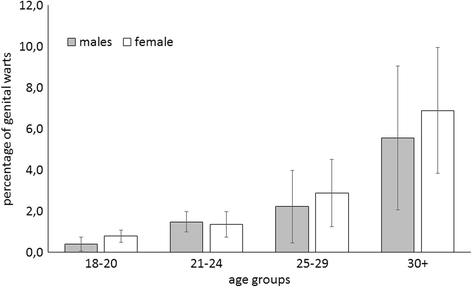Self-reported genital warts among sexually-active university students: a cross-sectional study
- PMID: 29334908
- PMCID: PMC5769424
- DOI: 10.1186/s12879-018-2954-7
Self-reported genital warts among sexually-active university students: a cross-sectional study
Abstract
Background: Genital warts are one of the most common forms of sexually-transmitted disease, but their epidemiology has yet to be thoroughly elucidated. The present study was designed to shed light on the prevalence of clinically-confirmed, self-reported genital warts (GWs) in a representative sample of the university population.
Methods: In 2015, a cross-sectional survey was conducted on 11,096 individuals approached at the Students Information Bureau where they came to enroll for a university degree course. Participants completed an anonymous, self-administered questionnaire providing information on their sociodemographic characteristics, sexual behavior, and any history of clinically-diagnosed genital warts. Multivariate logistic regression was then used to identify any factors associated with the disease.
Results: Our analysis was conducted on 9259 questionnaires (83.4%). Participants were a mean 21.8 ± 4.8 years of age, and 59.6% were female. Overall, 124 individuals (1.3%, 95%CI: 1.0-1.6) reported having been diagnosed with genital warts: 48 men (1.3%, 95%CI: 0.9-1.6), and 76 women (1.4% 95%CI: 1.1-1.7). Overall, 22.5% of the sample were vaccinated (1.3% of the males and 36.8% of the females). The group of respondents aged 30 years or more had the highest incidence of genital warts (males: 5.6%, 95%CI: 2.5-8.6; females: 6.9%, 95%CI: 3.4-10.4). The independent risk factors associated with a history of disease were (for both genders) a history of other sexually-transmitted diseases, and ≥2 sex partners in the previous 24 months. A protective role emerged for routine condom use. Additional risk factors associated with genital warts in males concerned men who have sex with men, bisexuality vis-à-vis heterosexuality, and smoking.
Conclusions: The findings emerging from our study help to further clarify the epidemiology of genital warts in young people, and may be useful to public health decision-makers. This study showed that genital warts occur in men as well as women, and suggests that both genders should be monitored for this disease to ascertain the effects of the free HPV vaccination offered to all girls in the Veneto in their 12th year of life since 2008, and to all boys of the same age since 2015.
Keywords: Genital warts; Human papillomavirus; Sexually-transmitted diseases.
Conflict of interest statement
Ethics approval and consent to participate
Data were treated with full confidentiality in accordance with Italian legislation. Written informed consent was obtained from all participants. To ensure anonymous nature of the data the informed consents were collected separately from questionarie. This study complies with the Declaration of Helsinki and the study protocol was approved by the ethical committee of the Padua Provincial Authority (date of approval 7/30/2015).
Consent for publication
Not applicable.
Competing interests
VB received grants for taking part on advisory boards and at expert meetings, and for acting as speaker and/or organizer of meetings/congresses. The other authors have no potential conflicts of interest to disclose.
Publisher’s Note
Springer Nature remains neutral with regard to jurisdictional claims in published maps and institutional affiliations.
Figures
Similar articles
-
Factors Associated with HPV Genital Warts: A Self-Reported Cross-Sectional Study among Students and Staff of a Northern University in Nigeria.Viruses. 2024 Jun 2;16(6):902. doi: 10.3390/v16060902. Viruses. 2024. PMID: 38932194 Free PMC article.
-
Genital warts in men: a large population-based cross-sectional survey of Danish men.Sex Transm Infect. 2012 Dec;88(8):640-4. doi: 10.1136/sextrans-2012-050512. Epub 2012 Sep 1. Sex Transm Infect. 2012. PMID: 22941865
-
The prevalence of genital warts in the Baltic countries: findings from national cross-sectional surveys in Estonia, Latvia and Lithuania.Sex Transm Infect. 2015 Feb;91(1):55-60. doi: 10.1136/sextrans-2014-051540. Epub 2014 Aug 7. Sex Transm Infect. 2015. PMID: 25104496
-
A new surveillance gynecological network to assess the incidence and prevalence of genital warts in the Italian female population: lessons learned.Minerva Ginecol. 2013 Oct;65(5):577-85. Minerva Ginecol. 2013. PMID: 24096294 Review.
-
Human Papillomavirus and Genital Warts: A Review of the Evidence for the 2015 Centers for Disease Control and Prevention Sexually Transmitted Diseases Treatment Guidelines.Clin Infect Dis. 2015 Dec 15;61 Suppl 8:S849-55. doi: 10.1093/cid/civ813. Clin Infect Dis. 2015. PMID: 26602622 Review.
Cited by
-
Population-level impact and herd effects following the introduction of human papillomavirus vaccination programmes: updated systematic review and meta-analysis.Lancet. 2019 Aug 10;394(10197):497-509. doi: 10.1016/S0140-6736(19)30298-3. Epub 2019 Jun 26. Lancet. 2019. PMID: 31255301 Free PMC article.
-
Perception and knowledge of HPV-related and vaccine-related conditions among a large cohort of university students in Italy.Hum Vaccin Immunother. 2019;15(7-8):1641-1649. doi: 10.1080/21645515.2018.1564432. Epub 2019 Feb 20. Hum Vaccin Immunother. 2019. PMID: 30689506 Free PMC article.
-
A cost-effectiveness analysis of adult human papillomavirus vaccination strategies in Italy.Hum Vaccin Immunother. 2025 Dec;21(1):2474891. doi: 10.1080/21645515.2025.2474891. Epub 2025 Mar 17. Hum Vaccin Immunother. 2025. PMID: 40094352 Free PMC article.
-
Time-trend of hospitalizations for anogenital warts in Veneto region in the HPV vaccination era: a cross sectional study (2007-2018).BMC Infect Dis. 2020 Nov 18;20(1):857. doi: 10.1186/s12879-020-05591-6. BMC Infect Dis. 2020. PMID: 33208109 Free PMC article.
-
Optimizing Assessment of Risk and Protection for Diverse Adolescent Outcomes: Do Risk and Protective Factors for Delinquency and Substance Use Also Predict Risky Sexual Behavior?Prev Sci. 2019 Jul;20(5):788-799. doi: 10.1007/s11121-019-0987-9. Prev Sci. 2019. PMID: 30645734 Free PMC article.
References
Publication types
MeSH terms
LinkOut - more resources
Full Text Sources
Other Literature Sources
Medical


